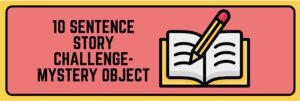Follow the steps given in this mini spark to practice your writing.
Spark your thinking!
1. Set up your language arts mini spark recording page: #30: 10 Sentence Story Challenge-Mystery Object
2. Watch this video. Write 3 notes on your recording about what will be easy about this challenge and what will be hard.
3. If you want to print out this handout you can, or open it up to look at as you write.
4. Work on your story. Check off each step from the handout as you write.
5. Go back to your story and underline each of the words the you used that were given by this challenge. Example: In sentence 1 you will underline the name that you picked.
6. Turn in your language arts mini spark to your teacher or EY coordinator.

 Learn how to sign animal names in this early enrichment mini spark.
Learn how to sign animal names in this early enrichment mini spark.





 Snapple is a brand of juice drinks. The company was founded in 1972 by Leonard Marsh, Hyman Golden, and Arnold Greenberg, who started selling fresh apple juice called Snapple out of the back of Greenberg’s parents’ pickle store in Queens, New York. The name Snapple is a combination of the words “snappy” and “apple”. This mini spark isn’t really about Snapple. It is about the facts that are printed on the lids.
Snapple is a brand of juice drinks. The company was founded in 1972 by Leonard Marsh, Hyman Golden, and Arnold Greenberg, who started selling fresh apple juice called Snapple out of the back of Greenberg’s parents’ pickle store in Queens, New York. The name Snapple is a combination of the words “snappy” and “apple”. This mini spark isn’t really about Snapple. It is about the facts that are printed on the lids.


 Where is your favorite place to eat pizza? My Top 3 are Sortinos, Mama’s Pizza, and Papa Johns. Of course whenever we eat pizza as a family, we have to make up some math problems! Explore some “pizza math”!
Where is your favorite place to eat pizza? My Top 3 are Sortinos, Mama’s Pizza, and Papa Johns. Of course whenever we eat pizza as a family, we have to make up some math problems! Explore some “pizza math”!
 This mini spark is all about the Emerald Isle! Ready to discover one of Europe’s most beautiful countries?
This mini spark is all about the Emerald Isle! Ready to discover one of Europe’s most beautiful countries?